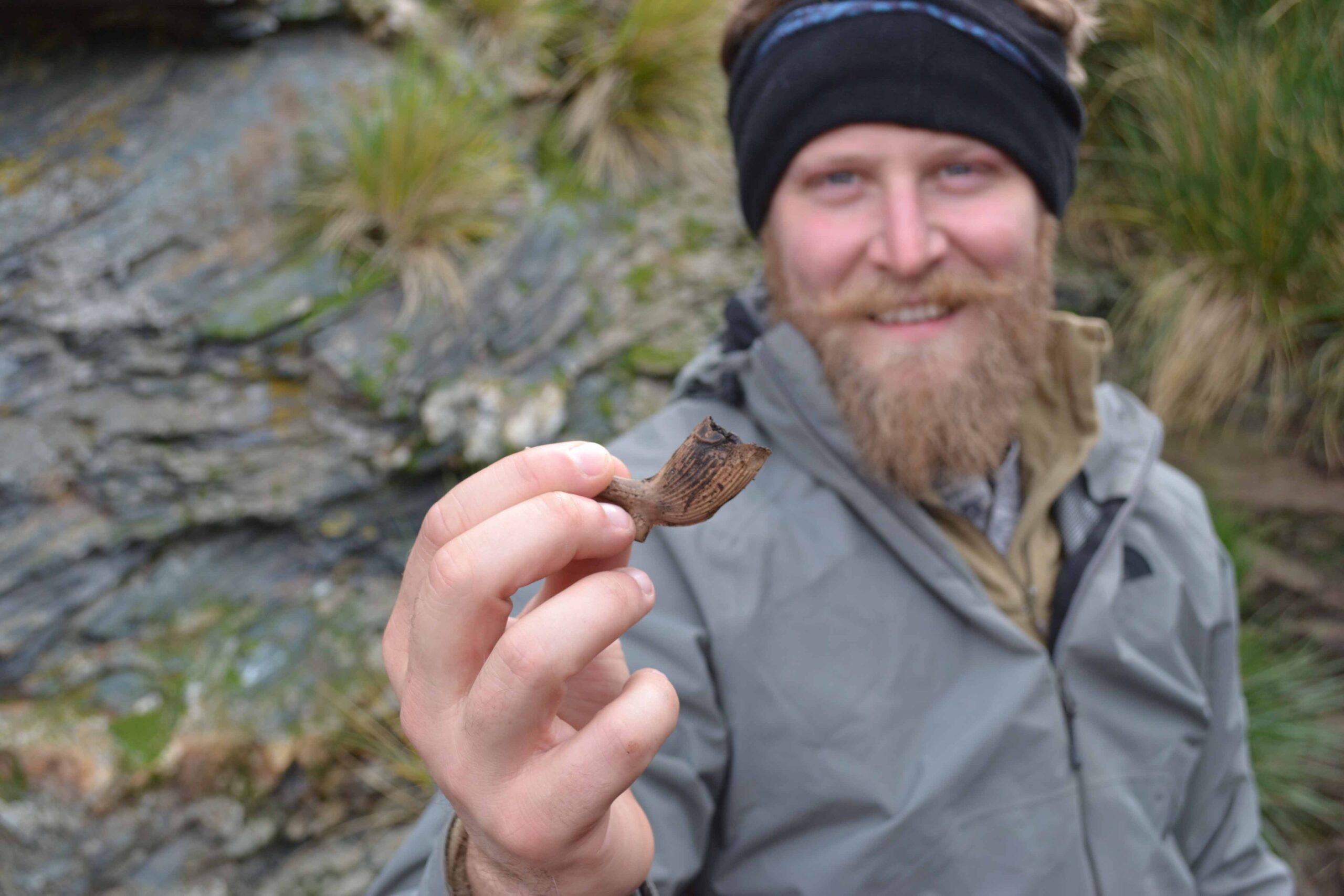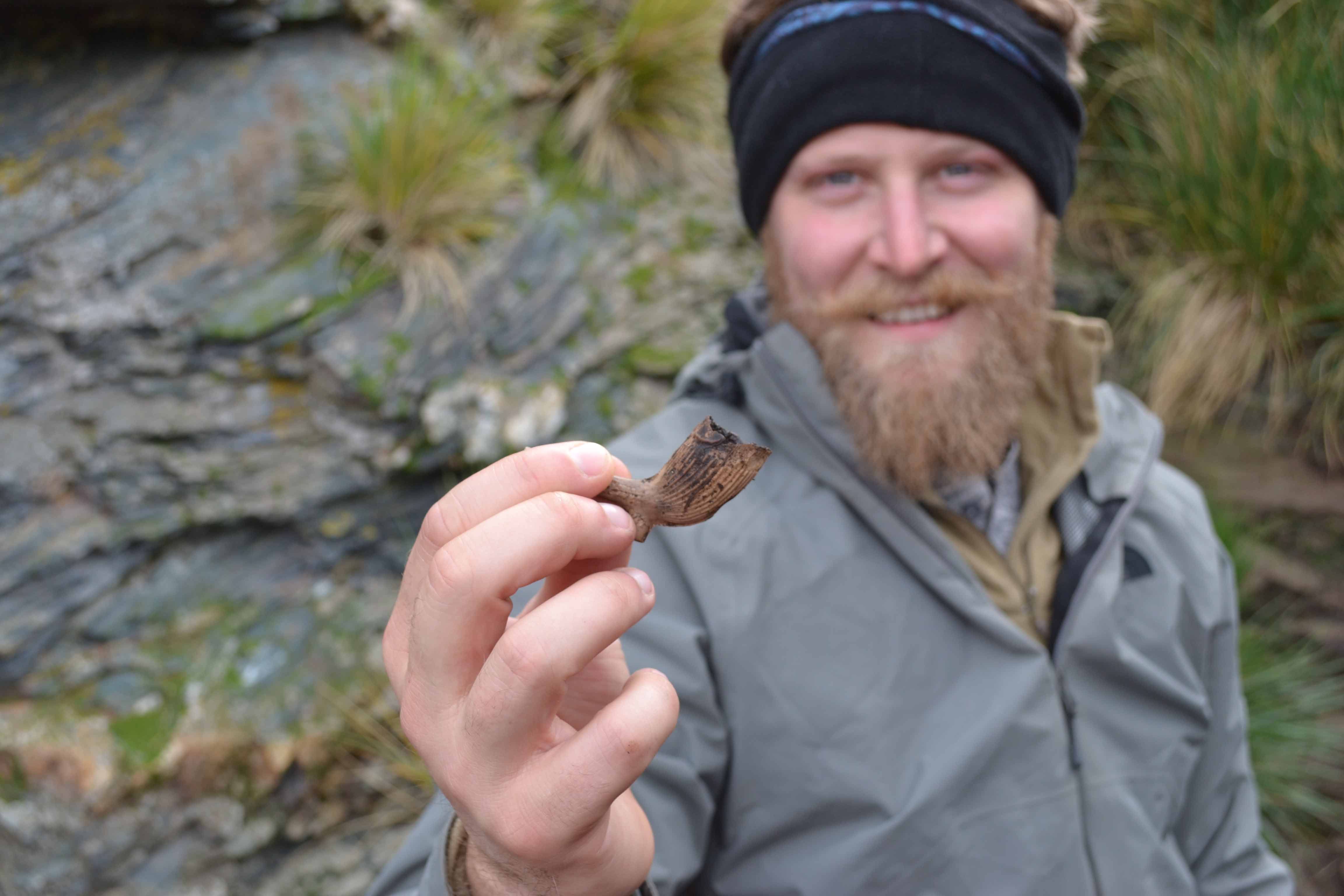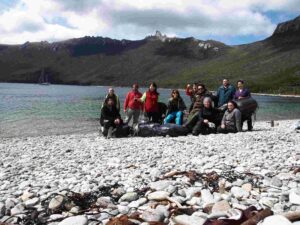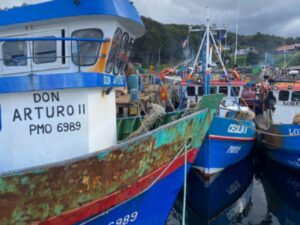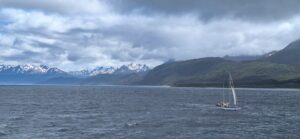Sealer’s Hut in Albatross Cove – Andrew, archeologist
Albatross Cove was one of those sites where we wanted to get a lot done in a very short space of time. The citizen scientists and ourselves started the day bright and early at Larsen Harbour, which only required a superficial survey consisting of scale drawings, photographs, metal detecting and approximate measurements of potential habitation areas. After a satisfying lunch and some efficient sailing, we reached our next site, Albatross Cove, for the second half of the day. The zodiac negotiated the kelp and rocky outcrops effortlessly and soon the team was scouring the beach for our next archaeological hot spot. Soon enough, one of our guides Dion pointed out to Marcus, the lead archeologist, a few planks of wood, half covered in tussac and mud, located in a perfectly calm alcove directly looking over the beach. Seals were going about their business just behind the archaeology, keeping to themselves in their well-worn abodes nestled in the tussac higher up the rock face.
Save for our endeavors at Elsehul, us Archaeologists were desperate for a bit of proper excavation and exploration after being constricted to just survey at most every other site previous; and what a site to choose for more detailed exploration! The plan of attack was to clean away the most intrusive tussac and mud to reveal the true extent (as much as we could) of the wooden structure. The team put in a great effort and we ended up moving a considerable amount of spoil. On one of my trips to the spoil heap, as I lifted my bucket of heavy spoil ready to dump, I noticed a strangely linear shape and bright colour, of which I had not yet come across amongst the stone and mud; somehow I managed to avert the direction of my spoil at the last second and hastily started swiping away at the spoil to further reveal the strange object. It turned out to be one of the artefacts we were hoping to find. Something that could potentially put a secure date on the deposits we were excavating, and start knitting everything we were investigating at Albatross into context; a ceramic tobacco pipe. This might sound underwhelming to you, the reader, but I must admit I shouted Marcus’s name rather enthusiastically, and proudly got my picture taken holding up the intricate, well made pipe. The pipe itself had most of the stem long broken-off and the aperture or bowl at the base was fractured and chipped, but there was enough detail on what remained to give us hope of a successful date.
The thrill of the finding spurred us all on, archaeologists and citizen scientists alike, and we continued working hard all the way through until sunset. A few iron nails as well as burnt animal bone and even a strip of leather was added to the artefact tally and this site was soon becoming one of the more significant sites we had encountered. At the end of the day we had located a hearth made of stone, the wooden floor surface nestled towards the back and most sheltered part of the cove and a collapsed wooden structure (potentially roof material) scattered towards the front of the building; yet we were not done with the discoveries this site held.
The next day we awoke with the knowledge we had a lot to finish with only half the day to do it in. We hit the shore at 0800 and got straight back to excavation. Alas, the team was not to find another tobacco pipe or anything to its equivalent, but we revealed more detail about the structure itself. Having left section lines in at key areas, with the help of Dion a potential interpretation was made on the use of tussac grass in such structures. It is not unknown for the sealers to have used tussac as a surface to lay boats on, or even as a make shift wall to form a wind-break, when layered the right way. Our sections and excavation backed this idea and so Ian, the environmentalist of the archaeology team, took adequate samples to test this theory back in Cambridge.
Just as we were finishing up and making the structure look beautiful for photography (which is surprisingly possible despite all the mud and dirt), Marcus dug a small trench uncovering a loose stone wall structure at the very front of the building. We now had a better picture of the kinds of systems sealers would have used in the nineteenth century to try and keep warm and dry and it looked something like this (certainly in this specific location);
· They initially looked for natural areas to provide shelter, such as alcoves, caves etc
· They would have reinforced such areas with a timber structure in which to live, most likely using natural barriers like rocks for walls wherever possible, and building roofs and floor surfaces as necessary
· Natural materials were utilised for extra reinforcements to the harsh conditions, this case in the form of a tussac wall (potentially)
· In front of which the sealers built an ad-hoc dry stone wall as another form of barrier to the weather and wildlife
I am aware this is just one site and sealer sites vary in extreme, however it was incredibly satisfying to start building a better, clearer picture of how nineteenth century sealers would have made decisions to deal with adverse weather conditions and wildlife. Albatross Cove is great to compare and contrast with Elsehul as we seem to have relatively in-depth archaeology from an industrial perspective (Elsehul) and a distinctly more domestic perspective at Albatross Cove.
*** thanks to all our readers for your comments – we’re reading them!**
**Anna and Bianca – Andrew and Ian are eating dessert every night***
#quixote-expeditions
#SGHT
#SouthGeorgia
#archeology
#hanshansson
#quixoteexpeditions

